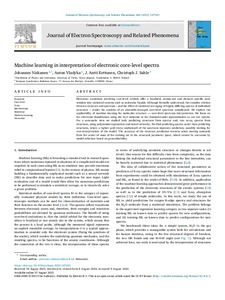Machine learning in interpretation of electronic core-level spectra
Niskanen Johannes; Vladyka Anton; Kettunen J. Antti; Sahle Christoph
https://urn.fi/URN:NBN:fi-fe2022091258778
Tiivistelmä
Electronic transitions involving core-level orbitals offer a localized, atomic-site and element specific peek window into statistical systems such as molecular liquids. Although formally understood, the complex relation between structure and spectrum -- and the effect of statistical averaging of highly differing spectra of individual structures -- render the analysis of an ensemble-averaged core-level spectrum complicated. We explore the applicability of machine learning for molecular structure -- core-level spectrum interpretation. We focus on the electronic Hamiltonian using the \ce{H2O} molecule in the classical-nuclei approximation as our test system. For a systematic view we studied both predicting structures from spectra and, vice versa, spectra from structures, using polynomial approaches and neural networks. We find predicting spectra easier than predicting structures, where a tighter grid (even unphysical) of the spectrum improves prediction, possibly inviting for over-interpretation of the model. The accuracy of the structure prediction worsens when moving outwards from the center of mass of the training set in the structural parameter space, which can not be overcome by model selection based on generalizability.
Kokoelmat
- Rinnakkaistallenteet [27094]
